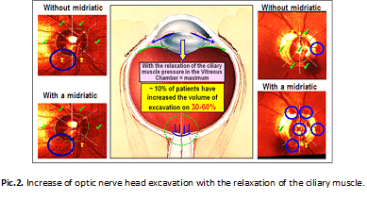Guseva Marina Gennadievna
Diagnostic Medicine Centre “Vodokanal SPb†Moscow, Russia
Title: The use of features of physiology and optics of the eye in rational optical correction
Biography
Biography: Guseva Marina Gennadievna
Abstract
Introduction: Traditionally, it is believed that the optical path of the eye has been studied thoroughly and does not require serious research. However, there are still a lot of "uncomfortable" questions that have not been answered. In particular, until now it was unclear the following:
 How do the side light rays get to the periphery of the lens and refract with contracted pupil, and are not blocked by the iris;
 How can light rays, located near the optical axis of the lens, be refracted, despite relatively small curvature of the anterior and posterior surfaces of capsule compared to the periphery;
 Where does white light dispersion occurs – inside the cornea or on the posterior surface of the cornea;
 What type of optical signal coming into the retina macular cones can detect - circles or light scattering bands of blue, green and red (BGR-bands);
 How does the system of "binocular guidance" of both eyes and their individual "optical aim» work in particular;
 What contribution does the cornea, which is a weakly scattering lens, make to the "assembling" optical system of the anterior segment of the eye;
 What should be considered the focus of the eye when it is impossible to simultaneously combine the foci of three wave BGR- fronts on a common focal plane due to the presence of optical axial aberration;
 Which highly reliable optical signal should form the accommodation mechanisms in the macula so that the brain can "track" the moment of accurate eye guidance on the allocated space or adjust the subject sharpness;
 What parameters of BGR-bands formed by the optical system of the eye should be able to fix the macula in general and its fovea in particular to form a feedback signal in the brain to control the ciliary muscle and the accommodation system as a whole;
 How, for example, changes the topography and the refractive power of the cornea by wearing orthokeratologic lenses (OK-lenses), and "optical turning-off" of which physiological adaptational mechanisms of OK-lenses are the most effective in dealing with acquired myopia.
Many unresolved issues in the optics of the eye are still the main obstacle in the creation of adequate laws of optics and mechanics of the theory of accommodation and working theory of myopia. The incremental-retinal defocus theory, which is quite popular today, is controversial, and its hypotheses often do not have a clear morpho-physiological basis [1]. And it is not possible to correctly carry out the correction of refractive disorders. It also became clear that weak understanding of the main features of the optical part of the visual tract of the eye, including the electrical part, stands in the way of creating more effective means of optical correction [1-4]. It is necessary to admit that the theory of optometry for now is poorly developed.
New theoretical and practical results: New executive mechanisms necessary for obtaining image sharpness due to the formation of an optical signal on the retina that is adequate to its physiological capabilities have already been identified [3,4]. Proposed in 2001 Koshits-Svetlova metabolic theory of adaptive myopia proved to be efficient and has already successfully passed clinical confirmation with follow-up periods of 3.5 and 7 years [5,6]. It became clear that a rational optical correction is needed, which uses a weak correction for the far sight, as well as a full correction or a weak correction for work at close range. This allows you to turn off the physiological adaptation mechanism of adjusting the length of the eye under visual load. In fact, this strategy implements OK-lenses. Rational correction is necessary in order to maintain a certain tension of ciliary muscle and with the aqueous humor to provide the transfer via the uveoscleral path a sufficient amount of ingredients for proper metabolism of the collagen structures of the middle and posterior part of the sclera to prevent the elongation of its posterior pole.
Our development of the theory of Helmholtz accommodation led us to understanding that in all phases of accommodation the lens is preloaded with a powerful front portion of fibers to the vitreous chamber (VC). The fibers of the cilliary zonule (CZ) are maximally stretched when looking into the distance and weakened (not relaxed!) when you look at near [7]. This allows the lens bag to be rounded as much as possible and more powerfully compress the intralenticular masses when looking at close distance (Pic.1). Pressing the lens to the vitreous chamber with the help of CZ fibers is carried out in all phases of accommodation and allows such a damping mechanism not only to securely hold the lens in the eye, but also to extinguish its oscillations under inertial loads.

Discussion: These theoretical ideas lead to important practical conclusions. In the case of appointment for the eye with acquired myopia optical under-correction for the ciliary muscle (CM) when looking into the distance and at medium distances is fully or partially relaxed and the amount produced by its processes of watery moisture is significantly reduced. This can significantly reduce the amount of ingredients delivered for normal intralenticular metabolism. There are significant prerequisites for the accelerated development of cataracts in myopic eyes with such irrational optical correction. For example, when looking into the far distance, the amount of intraocular fluid that is produced by the processes of the ciliary body is reduced three times compared to the sight at near, since the CM receives three times less blood [6].
For glaucomatous eyes in combination with myopia it is also very important to avoid under-correction of myopia, since relaxation of CM leads to an increase in pressure in the vitreous chamber, which in some cases provokes a jump in the magnitude of the optic disc excavation and increases the deformation of axons (Pic.2) [8].

In addition, the open angle glaucoma (OAG) in developed stages the uveoscleral outflow pathway (USOP) is already up to 80% of the total production of intraocular fluid (IF). However, with under-correction, the effectiveness of USOP significantly decreases, which disrupts the metabolism of intraocular structures and leads to an acceleration of their aging processes. Therefore, optical under-correction cannot be used for OAG.
On the contrary, it is advisable to apply a weak rational correction of 0.12-0.25 D in myopia for far sight distance, which will lead when working at medium and long distances to the tone of the CM, close to the average, when the production of IF in the processes of the ciliary body is normal. This is favorable for normal nutrition of the lens, and physiological conditions for accelerated development of cataracts do not occur. In addition, the pressure in the vitreous chamber with such optical correction is not at its the maximum, which reduces the optic nerve head excavation in the OAG. Therefore, it is advisable to use a weak correction to ensure vision in the distance for any refraction.
It is especially important in pair eyes with different refraction to perform a rational optical correction in such a way that both eyes have the same values of residual weak correction to ensure effective binocular work of both eyes. But the most important thing in the art of rational correction - is to provide the possibility of full implementation of the functional range of the ciliary muscle in its normal state to ensure the restoration (manifestation) of the entire physiological volume of accommodation.
Now we should consider the cases of providing comfortable vision at near distance. And here we need to solve two problems: to ensure the normal flow of metabolism in the lens and in the structures of the middle and posterior parts of the eye to prevent the development of cataracts, myopia or dystrophic changes in the retina with high myopia. To do this, it is necessary to "turn off" the usual executive mechanisms of adaptive selection of eye length under increased visual load. To be exact, with the help of competent optical correction, it is necessary to bring the tone of the CM to a state close to the average, which we have long defined as a "pre-installation of accommodation" [5,6]. This we denote as the concept of «optical control of the outflow».
Physiologically this can be achieved with a weak under-correction of 0.5-0.75 D for the near sight in the eyes of any refraction prolonged intensive work in close proximity (e.g., display). After all, with long-term «display visual loads», reaching the residents of megacitys from 5 to 12 hours a day, of course, there will be functional fatigue of СM, which in many developed countries has long been classified as a disease and is equivalent to an insured event. We are talking about computer vision syndrome (CVS). For its prevention, there is only one effective way – rational optical correction or preventive glasses for the near, and, we emphasize - even for healthy eyes. It is clearly necessary to take the next step and move massively to the usual and mandatory preventive correction, given the speed "myopia pandemic" spreads.
References
1. Koshits I.N., Svetlova O.V., Guseva M.G., Balashevich L.I., Makarov F.N., Egemberdiev M.B. Adaptive myopia. Part 1. Actuating mechanisms of optic axis growth in the incremental retinal defocus theory.- Ophthalmic journal,2016.- 6 (473): 45-58. [in Russian, in English].
2. Guseva M.G., Svetlova O.V., Koshits I.N. Stabilization of the acquired myopia in children with the aid of contact lenses from the standpoint of the metabolic theory of myopia.- Ophthalmic journal, 2011.- 6 (443): 29-36. [in Russian, in English].
3. Koshits I.N., Svetlova O.V. Adaptive myopia. Part 2. New views on the physiological mechanisms of the guidance of eyes to sharpen.- Ophthalmic journal,2017.- 1 (474): 38-50. [in Russian, in English].
4. Koshits I.N., Svetlova O.V. Adaptive myopia. Part 3. New mechanisms aiming to sharpen the eyes and their interaction with the mechanisms of the development of acquired myopia.- Ophthalmic journal,2017.- 2 (475): 36-57. [in Russian, in English].
5. Koshits I.N., Svetlova O.V. A mechanism of formation of the eye adequate length in the norm and metabolic theory of pathogenesis of acquired myopia.- Ophthalmic journal, 2011.- 5 (442): 4-23. [in Russian, in English].
6. Koshitc Ivan, Svetlova Olga, Guseva Marina. Physiological principles of rational optical correction. Practical recommendations. Normal physiology of the eye. Tutorial.- St. Petersburg: Northwestern State Medical University by name I.I. Mechnikov, 2016. - 152 Ñ. [in Russian].
7. Olga Svetlova, Ivan Koshits. Theory. Actuating mechanisms of accommodation and development of the theory of accommodation by Helmholtz.- Proceedings of 3rd Global Pediatric Ophthalmology Congress, 2018.- London, UK.- Journal of Clinical & Experimental Ophthalmology, March 2018.- Vol.9.- P. 66-70.
8. Svetlova O., Koshits I., Guseva M., Makarov F. Two key managers in the pathogenesis of OAG and innovative methods of early diagnosis.- 7th World Glaucoma Congress: Abstract book.- Helsinki, 2017.- P. 532.

